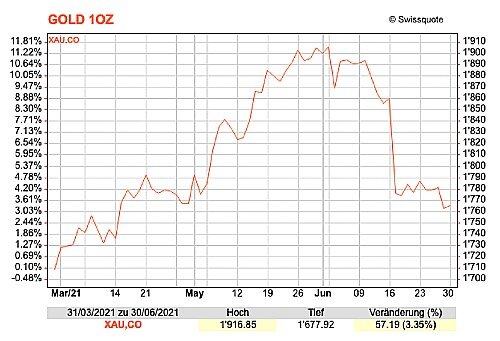Regulatory disclosures show that UBS and Credit Suisse's customers have behaved very differently as far as exchange-traded gold funds go.
Credit Suisse sold 37 percent of its holdings in SPDR Gold Shares, the world’s largest gold exchange-traded fund, in the second quarter taking its stake to a value of around $131 million, according to an analysis of regulatory disclosures by industry portal «Goldreporter» (in German). The bank sold more fund shares in percentage terms than the world's largest asset manager BlackRock (29 percent)
Credit Suisse’s fellow large Swiss bank, UBS made a move in completely the opposite direction. It increased its stake in the fund over the same period by 4.85 percent to over $1 billion. UBS is one of the largest investors in the index fund after Bank of America and Morgan Stanley.
Both the Swiss banks’ moves have come at a time when the gold price fluctuated massively. Gold had climbed to over $1,900 a troy ounce by the beginning of June, only to plummet to below $1,770/oz by the end of the month. Viewed over the quarter, the precious metal rose by a less than golden 3.35 percent (see chart below).
(Chart: Swissquote)
Further Falls
The gold price fell again in August, taking the drop since the beginning of the year to almost 5 percent. Gold is now trading at around $1,800/oz. Banks usually invest in SPDR Gold Shares on behalf of their customers, the report says.
Looking back, did Credit Suisse have a better take on the market and advise its clients to take their profits in good time? At the end of July, Credit Suisse was again very bullish on gold.
«We are assuming that the gold price will be $2,000/oz at the end of 2021,» the bank’s analysts said. They based their forecast on falling bond yields and a continuation of loose monetary policy and the resulting low-interest rates. Gold was also still suitable as means of portfolio diversification, both against high global debt and emerging cryptocurrencies.
UBS Bearish Recently
By contrast, UBS analysts have recently been bearish. In mid-August, they told the «Bloomberg» news agency (behind paywall) that prices could fall to $1,600/oz.
«If we assume that the world is changing for the better - why do we need an investment that is primarily used as portfolio insurance?» the UBS analysts said. The bank added that silver and platinum would now be the better investments.
Safe Haven?
Other traders see the rising inflation and the potential response by central banks as medium-term dangers to gold. Interest rate hikes are in the air, for example in the U.S, which would make the dollar appreciate. That in turn would be bearish for gold.
On the other hand, global uncertainties have recently increased – there are third and fourth waves of the coronavirus pandemic, and the Taliban's seizure of power in Afghanistan is becoming a geopolitical risk. Quite a few investors are likely to rediscover gold as a safe haven.
It is not easy to make sense of these mixed signals, especially when banks’ recommendations diverge. Who made the right choice will become clear when the regulatory disclosures for the third quarter have been sifted through.



























